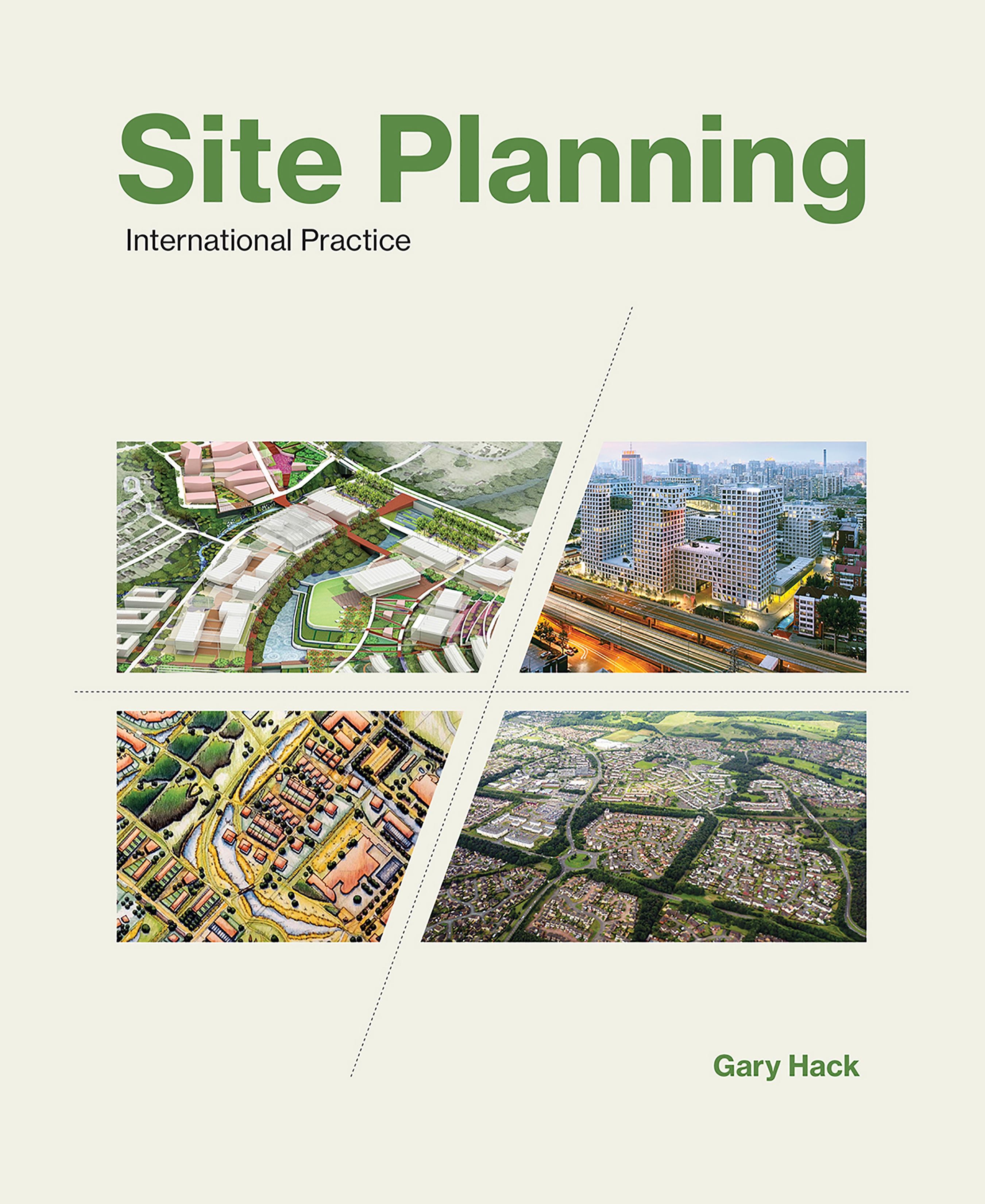Gary Hack - Site Planning
Here you can read online Gary Hack - Site Planning full text of the book (entire story) in english for free. Download pdf and epub, get meaning, cover and reviews about this ebook. year: 0, genre: Art / Science. Description of the work, (preface) as well as reviews are available. Best literature library LitArk.com created for fans of good reading and offers a wide selection of genres:
Romance novel
Science fiction
Adventure
Detective
Science
History
Home and family
Prose
Art
Politics
Computer
Non-fiction
Religion
Business
Children
Humor
Choose a favorite category and find really read worthwhile books. Enjoy immersion in the world of imagination, feel the emotions of the characters or learn something new for yourself, make an fascinating discovery.

Site Planning: summary, description and annotation
We offer to read an annotation, description, summary or preface (depends on what the author of the book "Site Planning" wrote himself). If you haven't found the necessary information about the book — write in the comments, we will try to find it.
Site Planning — read online for free the complete book (whole text) full work
Below is the text of the book, divided by pages. System saving the place of the last page read, allows you to conveniently read the book "Site Planning" online for free, without having to search again every time where you left off. Put a bookmark, and you can go to the page where you finished reading at any time.
Font size:
Interval:
Bookmark:

Site Planning
Site Planning
International Practice | Gary Hack
The MIT Press | Cambridge, Massachusetts | London, England
2018 Gary Hack
All rights reserved. No part of this book may be reproduced in any form by any electronic or mechanical means (including photocopying, recording, or information storage and retrieval) without permission in writing from the publisher.
Library of Congress Cataloging-in-Publication Data
Names: Hack, Gary, author.
Title: Site planning : international practice / Gary Hack.
Description: Cambridge, MA : The MIT Press, 2018. | Includes bibliographical references and index.
Identifiers: LCCN 2017029083 | ISBN 9780262037389 (hardcover : alk. paper) | ISBN 9780262534857 (pbk. : alk. paper)
Subjects: LCSH: Building sitesPlanning. | Architectural practice.
Classification: LCC NA2540.5 .H33 2018 | DDC 720dc23 LC record available at https://lccn.loc.gov/2017029083
EPUB version 1.0
Preface
This international edition of Site Planning continues a long tradition of compiling and distilling the experiences of designing settlements on the land, as a guide for students and practitioners of the art of site planning. It emphasizes the importance of sustainability, cultural attitudes, and emerging technologies that can overcome the sameness that afflicts so much development today. Sites, and the way we inhabit them, support the sense of localism that we must not lose.
In his preface to City Planning, with Special Reference to the Planning of Streets and Lots, the first American textbook on site planning, Charles Mulford Robinson wrote:
A book of this kind, whatever its other deficiencies, must not be one of fine-spun theory. It must be practical, if it is to be serviceable. It must depend for value upon what it can draw from the experience of many cities and many nations, and from the thoughts of many practitioners. It must represent the slow fruition of years devoted, not to introspective study, but to research in places and books and recordsand among the men who are doing the actual work of city building. (Robinson 1916)
Robinson, the first professor of civic design at an American university, drew together knowledge gained from almost half a century of progress and experimentation, from Olmsteds remarkable plan for the village of Riverside, Illinois (1859) to the prosaic suburban subdivisions that were proliferating on the fringes of every Midwest city. Much of the knowledge of land planning then, as today, resided with individual consultants; the Olmsted firm alone planned over 50 residential developments across the US. City Planning, together with Robinsons earlier tract The Width and Arrangement of Streets (1911), conveyed best practices and served as manuals for planning new streets, lots, parks, and centers. They also became textbooks for educating the growing number of professionals in city planning, landscape architecture, architecture, and civil engineering.
Other books from Europe also became widely used in the US in the early decades of the twentieth century, especially Raymond Unwins Town Planning in Practice: An Introduction to the Design of Cities and Suburbs (1909), rooted in the garden city experience. And texts for site planning continued to evolve after Robinsons pioneering volumes, each updating the state of the art. F. Longstreth Thompsons Site Planning in Practice (1923), which includes a preface by Unwin, drew together the salient issues in the planning of housing estates. It was the first book to use the term site planning in its title, and covered topographic issues, street types and dimensions, the form and aesthetics of housing areas, and infrastructure for sites.
Thomas Adams, also a veteran of the garden city movement, covered some of the same territory in his book The Design of Residential Areas (1934), adding Canadian and US examples, including his work in the reconstruction of Halifax, Nova Scotia after the great explosion of 1917. Adams designed the new planning curriculum at MIT, and during the 1930s site planning became a required course in most architecture and planning programs in US universities. Robinsons and Adamss books were the favored textbooks. In 1939, the US government also got into the act with the highly influential guidebook Design of Low-Rent Housing Projects: Planning the Site, issued by the United States Housing Authority.
Kevin Lynch began teaching site planning shortly after he arrived at MIT as a junior faculty member in 1949, sharing notes and ideas with Hideo Sasaki who taught a similar course at Harvard, and inheriting materials assembled over the years by Draveaux Bender on planning site infrastructure. Gradually the subject evolved to reflect Lynchs special passion for the value of landscape and his lifelong interest in how people sense and experience places. His first edition of Site Planning was published by the MIT Press in 1962, reflecting these sensibilities while not shying away from the analytics, rules of thumb, and technical detail required to create a practical site plan. A second edition followed in 1972, and I had the pleasure of joining him in preparing a third edition, published in 1984. In it we sought to expand the scope of site planners knowledge beyond the physical aspects of sites to include issues of economics, logistics of site construction, and public engagement in the planning of sites. The contents of the book were largely drawn from the North American experience. Nonetheless the book was translated into several languages, and to my dismay continues to be widely used in other societies without accounting for cultural differences. I hope to compensate for that in this international edition.
Much has changed since the publication of the last edition of Site Planning. Issues of sustainability have become critical, reflecting the existential threat of climate change. We are learning how to predict and minimize the environmental effects of site development. Lessening the draw on unrenewable resources, including energy, materials, and water, has become an imperative in both building and maintaining sites. Infrastructure technologies have improved dramatically, loosening the dependence on large public systems. We know much more today about how people use and value public spaces, and the cultural differences that shape activities in common spaces. Public engagement has become a norm in decisions about site development, and predictions about site impacts are important in the debates about what should be permitted. The emergence of hyperdensity in many cities across the globe, and the growing preference for mixing work, living, shopping, and recreation, demand new ways of thinking about site development. Currently some of the most innovative site planning and development projects may be found in Asia and the Southern Hemisphere, where growth rates outdistance those in older cities of the West. And, of course, planners work quite differently today: using digital tools, drawing resources from the Internet, collaborating electronically, and moving seamlessly from site data to concepts to detailed plans for sites. Many of the tasks done by hand three decades ago have been reduced to apps that reveal results in an instant.
The format of this book is a response to the fast-changing nature of the practice of site planning. Each of its 40 chapters covers a discrete subject, organized in five broad areas: values and visions that guide site planning, site analysis techniques, site planning processes, site infrastructure, and prototypes of site development. This modular format will allow new information and examples to be added to the electronic version of the book, and to reissues of the print edition. Much as automobile models are improved through continuous change, my intent is to initiate an ever-evolving volume on site planning.
Font size:
Interval:
Bookmark:
Similar books «Site Planning»
Look at similar books to Site Planning. We have selected literature similar in name and meaning in the hope of providing readers with more options to find new, interesting, not yet read works.
Discussion, reviews of the book Site Planning and just readers' own opinions. Leave your comments, write what you think about the work, its meaning or the main characters. Specify what exactly you liked and what you didn't like, and why you think so.








